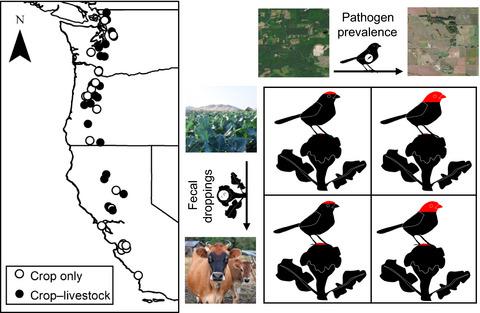当前位置:
X-MOL 学术
›
J. Appl. Ecol.
›
论文详情
Our official English website, www.x-mol.net, welcomes your feedback! (Note: you will need to create a separate account there.)
Agricultural intensification heightens food safety risks posed by wild birds
Journal of Applied Ecology ( IF 5.7 ) Pub Date : 2020-08-24 , DOI: 10.1111/1365-2664.13723 Olivia M. Smith 1, 2 , Amanda Edworthy 3, 4 , Joseph M. Taylor 2, 3 , Matthew S. Jones 3, 5 , Aaron Tormanen 1, 3, 6 , Christina M. Kennedy 7 , Zhen Fu 3, 8 , Christopher E. Latimer 7 , Kevin A. Cornell 1 , Lucas A. Michelotti 2, 3 , Chika Sato 1 , Tobin Northfield 3, 5, 9 , William E. Snyder 2, 3 , Jeb P. Owen 3
中文翻译:

农业集约化加剧了野生鸟类造成的食品安全风险
更新日期:2020-08-24
Journal of Applied Ecology ( IF 5.7 ) Pub Date : 2020-08-24 , DOI: 10.1111/1365-2664.13723 Olivia M. Smith 1, 2 , Amanda Edworthy 3, 4 , Joseph M. Taylor 2, 3 , Matthew S. Jones 3, 5 , Aaron Tormanen 1, 3, 6 , Christina M. Kennedy 7 , Zhen Fu 3, 8 , Christopher E. Latimer 7 , Kevin A. Cornell 1 , Lucas A. Michelotti 2, 3 , Chika Sato 1 , Tobin Northfield 3, 5, 9 , William E. Snyder 2, 3 , Jeb P. Owen 3
Affiliation

|
- Agricultural intensification and simplification are key drivers of recent declines in wild bird populations, heightening the need to better balance conservation with food production. This is hindered, however, by perceptions that birds threaten food safety. While birds are known reservoirs of foodborne pathogens, there remains uncertainty about the links between landscape context, farming practices, and actual crop contamination by birds.
- Here, we examine relationships between landscape context, farming practices, and pathogen contamination by birds using a barrier‐to‐spillover approach. First, we censused bird communities using point count surveys. Second, we collected 2,024 faecal samples from captured birds alongside 1,215 faecal samples from brassica fields and food processing areas across 50 farms spanning the USA West Coast. We then estimated the prevalence of three foodborne pathogens across landscape and livestock intensification gradients. Finally, we quantified the number of plants with faeces.
- Campylobacter spp. were detected in 10.2% of faeces from captured birds and 13.1% of faeces from production areas. Non‐native birds were 4.1 times more likely to have Campylobacter spp. than native birds. Salmonella spp. were detected in 0.2% of faeces from production areas and were never detected in captured birds. We detected evidence of Shiga toxigenic E. coli in one sample across the >3,200 tested.
- Campylobacter spp. prevalence in faeces from production areas increased with increasing mammalian livestock densities in the landscape but decreased with increasing amounts of natural habitat.
- We encountered bird faeces on 3.3% of plants examined. Despite the impact on pathogen prevalence, amount of natural habitat in the landscape did not increase the number of plants with bird faeces, although on‐farm mammalian livestock density slightly did.
- Synthesis and applications. Food safety and wildlife conservation are often thought to be in conflict. However, our findings suggest that natural habitat around farms may reduce crop contamination rates by birds. This is perhaps because natural habitat can promote native birds that are less likely to harbour foodborne pathogens or because it decreases contact with livestock waste. Our results suggest that preservation of natural habitats around farms could benefit both conservation and food safety, contrary to current standards for ‘best practices’.
中文翻译:

农业集约化加剧了野生鸟类造成的食品安全风险
- 农业集约化和简化化是近期野生鸟类数量下降的主要驱动力,从而提高了在保护与粮食生产之间取得更好平衡的需要。但是,这被认为鸟类威胁食品安全的观念所阻碍。尽管鸟类是食源性病原体的已知储集地,但景观环境,耕作方式与鸟类对作物的实际污染之间的联系仍然不确定。
- 在这里,我们使用溢出障碍方法研究了景观环境,耕作方式和鸟类对病原体的污染之间的关系。首先,我们使用点数调查对鸟类群落进行了调查。其次,我们从跨越美国西海岸的50个农场的芸苔田和食品加工区收集了2,024份捕获鸟类的粪便样本,以及1,215份粪便样本。然后,我们估算了三种食源性病原体在景观和家畜集约化梯度中的流行程度。最后,我们量化了带粪便的植物的数量。
- 弯曲杆菌属。在捕获的禽类的粪便中检出了10.2%,在生产地区的粪便中检出了13.1%。非本地鸟类患弯曲杆菌的可能性要高4.1倍。比本地鸟类 沙门氏菌属。在生产区域的粪便中检出0.2%,从未在捕获的鸟类中检出。我们在超过3200个测试样品中的一个样本中检测到了志贺毒素大肠杆菌的证据。
- 弯曲杆菌属。生产地粪便中的流行率随着景观中哺乳动物牲畜密度的增加而增加,但随着自然栖息地数量的增加而降低。
- 我们在3.3%的受检植物上遇到了鸟粪。尽管对病原体的流行有影响,但自然环境中的栖息地数量并没有增加带有鸟粪的植物数量,尽管农场上的哺乳动物牲畜密度略有增加。
- 综合与应用。人们通常认为食品安全和野生动植物保护存在冲突。但是,我们的发现表明,农场周围的自然栖息地可能会降低鸟类对农作物的污染率。这也许是因为自然栖息地可以促进不太可能携带食源性病原体的本地鸟类,或者因为它减少了与牲畜废物的接触。我们的结果表明,与现行的“最佳做法”标准相反,保护农场周围的自然栖息地可能有益于保护和食品安全。



























 京公网安备 11010802027423号
京公网安备 11010802027423号